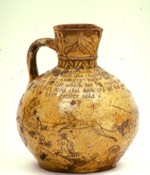NORTH DEVON POTTERY


Historian and author Alison Grant has completed her book on North Devon Pottery.
Introduction to the book
Many North Devon people are interested in local pottery. They appreciate
especially the handsome harvest jugs with their bold designs of ships in
full sail, or rural landscapes with verses that evoke scenes of peace
and plenty and the jovial atmosphere of harvest suppers. Most of these
jugs were made in the nineteenth century, a relatively late period in
the history of the industry. Until recently, nothing was known of its
earlier development. When Llewellyn Jewitt visited North Devon to gather
material for his pioneering work on ceramic art in Britain, published in
1878 he found that local memories did not go back before 1800. He was
shown only one ‘interesting relic’ of earlier times, an earthenware
chimney-pot from a Bideford pottery bearing the date 1668. In the two
hundred years that had passed, the names of earlier potters had been
forgotten and knowledge of their work lost, yet the seventeenth and
early eighteenth centuries had been the period of the greatest expansion
of the industry. This became clear in 1960, when Malcolm Watkins
published the first study of North Devon pottery to make use of
archaeological finds. Since then archaeologists have been able to
identify sherds of North Devon ware from excavations. These finds add a
new dimension to the study of the industry, for as well as enabling the
fabric and form of past products to be examined, they provide important
evidence of their distribution.
Archaeological evidence is used in this book to help rediscover some of
the forgotten past of the North Devon pottery industry, and most of the
seventeenth-century information is drawn from the documentary sources
used for the University of Exeter PhD thesis in history on which the
first edition was based. For the second edition I am adding a little
about medieval pottery, which archaeologists are now finding was also
made in North Devon, and am including the pottery of later centuries.
Therefore this edition is considerably larger.
For the purposes of the study, North Devon is defined as the area within
a radius of approximately fifteen miles from the market towns of
Barnstaple, Bideford and Great Torrington. In this edition, the
manufacture of pottery, and the wares themselves are described first.
The book then identifies many North Devon potters, but not every man or
boy who worked as a potter’s labourer in the nineteenth and twentieth
centuries, as some probably never threw a pot! Potters are discussed in
the context of the communities in which they lived and worked. As
before, the last part of the book is concerned with the distribution and
marketing of the wares, showing that North Devon became the pivot of a
fan of commerce extending, at its greatest point, westward as far as the
colonies in North America and the West Indies. In the
seventeenth-century the pottery industry had more than local
significance, and played an important part in some aspects of Irish
trade, as well as the early development of the colonies. In later years,
these markets contracted considerably, and the industry itself declined.
In spite of many changes, however, an industry still exists, after over
800 years, and its influence past, present and even future, has been,
and is, immeasurable.
Chapter 1 Raw materials and
fuel
Chapter 2 Making and firing pottery
Chapter 3 Wares
Chapter 4 Bideford
Chapter 5 Barnstaple
Chapter 6 Great Torrington and the villages
Chapter 7 Inland trade
Chapter 8 Coastal trade: Wales
Chapter 9 Coastal trade: the West Country
Chapter 10 Overseas trade
‘NORTH DEVON
POTTERY’ is published
by Lazarus Publishing
and costs £20.
Tel: 01237 421195
Tel: 01237 425520
Lazarus Publishing, Unit 7, Caddsdown
Industrial Park, Clovelly Road, Bideford, Devon, UK

